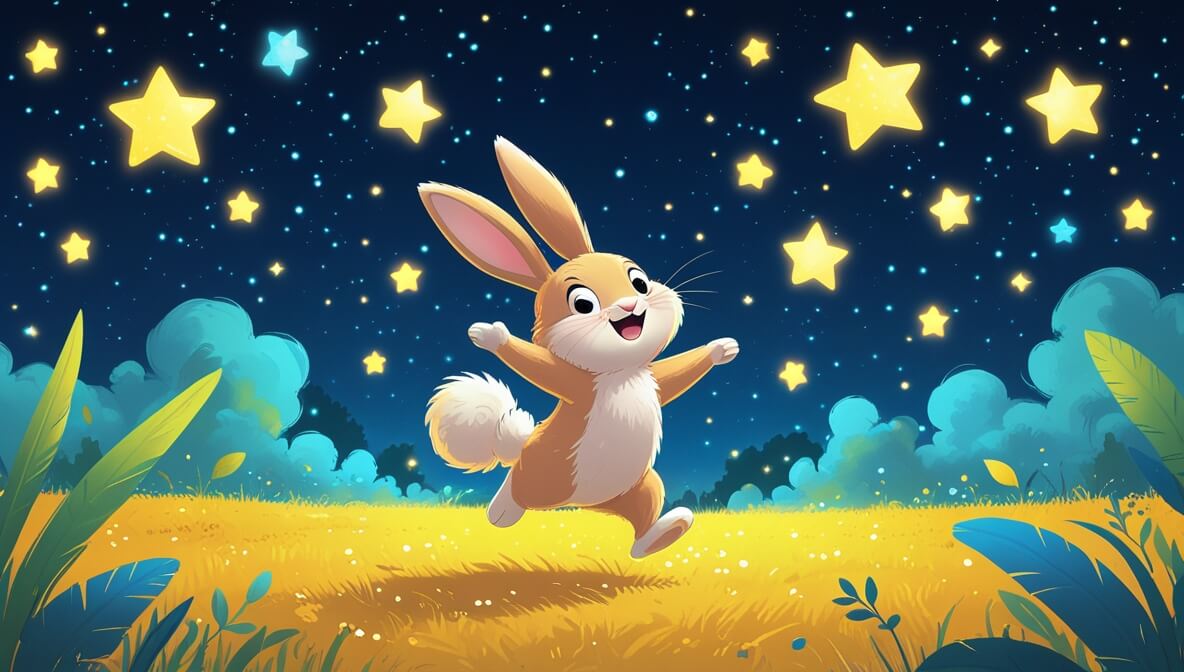In a gentle meadow where dreams come alive, a little bunny and a twinkling star embark on a journey of friendship and wonder.
Age Recommendation
0 – 4 years
Characters
Characters:
- Wiggles (a curious bunny with a fluffy tail)
- Glowy (a twinkling star who loves to dance)
Story
Once upon a time, in a meadow that glowed like gold, a little bunny named Wiggles hopped happily. Every night, Wiggles saw a bright star named Glowy twinkling in the sky. Wiggles always wondered, “How does Glowy shine so bright?”
The Starry Dance
One night, Glowy noticed Wiggles looking up with wide eyes. “Hello, Wiggles!” Glowy called out with a sparkle. “Do you want to know how I shine?” Wiggles nodded excitedly. Glowy twirled, sending a shower of twinkles down. “I shine because I share my light with friends!”
A Magical Journey
Glowy invited Wiggles to join in a dance among the stars. With a hop and a wiggle, Wiggles found himself floating up, up, up! The stars surrounded him, and they all danced together in the sky. Wiggles felt the warmth of friendship, making him shine as bright as Glowy.
The Meadow’s Surprise
When they returned to the meadow, the flowers glowed with the star’s sparkle. Wiggles realized that just like the stars, he could share happiness with others. Glowy twinkled, “Remember, Wiggles, your heart’s light can brighten any night.”
The end.
Moral of the Story
Friendship and kindness make our hearts shine bright, just like stars in the night sky.
Questions to Think About
- Why do you think Wiggles wanted to shine like Glowy?
- How did Wiggles and Glowy become friends?
- What did Wiggles learn about sharing light?
- How can you share your light with others?
- What do you think Wiggles will do with his new light?
Do You Know
- Stars are giant balls of hot gases that shine brightly in the sky.
- Bunnies can hop very high using their strong back legs.
Word Explorer
- Twinkle: A little light that sparkles and shines.
- Meadow: A field of grass and flowers.
- Friendship: A special bond between two or more friends.
Emotions in the Story
- Curiosity: Wiggles felt curious when he wondered how Glowy shined so bright.
- Happiness: Wiggles felt happy when he danced with Glowy among the stars.
- Warmth: Wiggles felt warmth from the friendship he shared with Glowy.
Color Your Scene
Imagine Wiggles and Glowy dancing under the starry sky. Can you draw Wiggles with his fluffy tail and Glowy with all her twinkling friends? Use bright yellows, blues, and whites to make the stars shine!
Parents’ Corner
This story is a wonderful way to introduce the concept of sharing and friendship to your child. Discuss how Wiggles learned to share his happiness and how your child can do the same with their friends and family. Use this opportunity to encourage your child to find ways to brighten someone’s day, whether through a smile, a kind word, or a simple hug.











